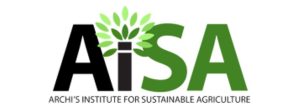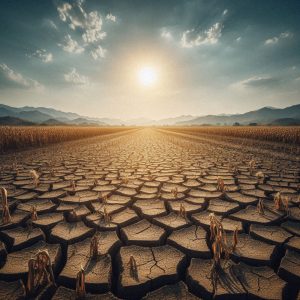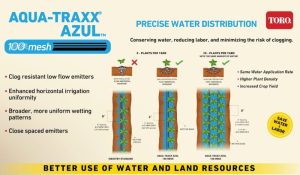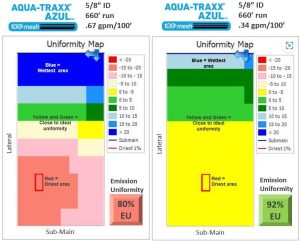Original article by Western Farm Press (Amy Roberts)
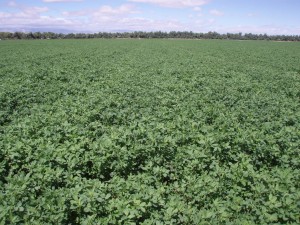 Alfalfa growers may be encouraged to take a fresh look at subsurface drip irrigation (SDI) based on promising work underway at the Burford Ranch in Five Points, Calif.
Alfalfa growers may be encouraged to take a fresh look at subsurface drip irrigation (SDI) based on promising work underway at the Burford Ranch in Five Points, Calif.
Francisco Parra, an agronomist and pest control advisor at Burford Ranch, presented preliminary information at an alfalfa pest and crop management meeting held in Dos Palos, Calif. in June on switching the ranch’s Roundup Ready alfalfa acreage to SDI on 60-inch beds to maximize water efficiency.
He also provided additional details in a follow-up interview.
“By choice or necessity, we decided that we would deviate away from sprinkler irrigation to maximize every single inch of water we have,” Parra said, due to the state’s continuing drought and subsequent water shortages impacting farmers.
Burford Ranch and other operations on the west side of Fresno County are land rich but water poor. Continuing drought conditions and regulations are diverting water for species’ protection and habitat restoration.
This year, farming operations in the Westlands Water District, including Burford Ranch, only received a five-percent surface water allocation. For now, Parra is using most of the ranch’s carryover water from the previous year – along with the limited allocation – to maintain almond and wine grape acreage where there no well water exists.
Parra says his father – Sal Parra, Burford Ranch’s general manager – saw the writing on the wall. They believed that continued water shortages could plague their ability to maximize the farm’s resources. They chose to try growing alfalfa seed with SDI to use water more efficiently and better manage the irrigation of the crop.
Irrigation scheduling
The junior Parra says irrigation scheduling becomes more critical after initial seed set in alfalfa seed production.
“At that point, fields can become overwatered,” Parra said. “We believed drip could result in more efficient water use and maximize seed production since the emitters are uniformly distributed across the field compared to flood irrigation.”
The Parra’s experienced positive results with the alfalfa seed crop grown with subsurface drip. They witnessed rapid plant growth in drip and decided to focus attention on trying to grow alfalfa hay with SDI.
Since the ranch already had plenty of aluminum pipe available from furrow and sprinkler irrigation, the Parras modified the drip system to incorporate the pipe instead of buying new PVC which would normally be buried.
After evaluating different gauges of drip tape, they opted for a 15-millimeter and 1 3/8-inch product placed about 10 inches below the surface for five years.
The SDI lines are fed by a 4-inch layflat pipe made of a rubber-based material. It allows harvesting equipment to enter the field under dry conditions. Valves feed the 4-inch lines from the 12-inch aluminum pipe which is implemented when irrigating and moved aside after irrigation.
Parra figures the modified system costs $800-$1,000 per acre. A comparable and complete SDI system would cost $1,300-$1,500 per acre.
Under sprinkler, Parra says on average it requires nine inches of water per acre per cutting at a cost of about $380 per acre foot. Labor costs totaled $20 per acre per cutting to move lines. The alfalfa was cut six times and yielded about three-quarters to one ton per acre.
Using drip, Parra says about four inches of water are used in two 48-hour sets per cutting. The irrigations are four days apart to maintain optimal soil moisture. Labor costs total about $2.50 per acre per cutting. The crop is cut 7-8 times per year.
Yields have increased to almost two tons per acre per cutting.
Lower labor costs
Besides the water savings, there are other benefits to SDI including reduced labor costs, better growth uniformity across the field, higher hay quality and yields per cutting, more vigorous growth, plus reduced weed, pest, and disease pressure.
Parra said, “We saw an increase in quality but we do not have specific data to support this observation.”
He says the operation needs to conduct research to validate the cost effectiveness of SDI in alfalfa for hay taking into account different parameters.
Although Parra has working figures highlighting the value of using drip, he may parlay those numbers into his thesis project towards his Master’s degree at California State University, Fresno. He would compile past flood and sprinkler ranch production data – including water use, yields, and sprinkler-irrigated alfalfa quality – and compare it against drip irrigated fields.
Despite yield increases, Parra remains vigilant to limit problems which lead to reduced irrigation system efficacy. Emitter clogs, root intrusions, iron buildup, and leaks (often caused by gophers or voles) can lead to uneven water distribution, stand loss, and an overall decrease in crop production.
Parra believes that this can be reduced through teamwork on the ranch.
“We all do our part in preserving the integrity of the drip tape,” he said. “If any of us on the ranch drive by the field and notice a new gopher mound or vole hole, we will either take care of the problem ourselves or contact the on-site irrigator.”
To date, a rotation crop is not used in the SDI fields.
If the observed benefits of drip-irrigated alfalfa pan out, Parra believes drip irrigation could add a couple of years to alfalfa stand productivity.
“If the hay market maintains its current price levels, we will work to keep the fields in alfalfa as long as the fields are profitable,” Parra said.
“At the end of the day, you have to take into account markets and different parameters to get the most out of the life of the tape.”

